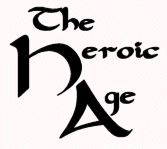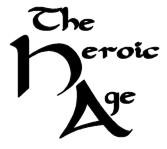Electronic Medievalia
O Captain! My Captain! Using Technology to Guide Readers Through an Electronic Edition
Daniel Paul O'Donnell
University of Lethbridge
© 2005 by Daniel Paul O'Donnell. All rights reserved. This edition copyright © 2005 by The Heroic Age. All rights reserved.
O CAPTAIN! my Captain! our fearful trip is done;
The ship has weather'd every rack, the prize we sought is won;
The port is near, the bells I hear, the people all exulting,
While follow eyes the steady keel, the vessel grim and daring:
But O heart! heart! heart!
O the bleeding drops of red,
Where on the deck my Captain lies,
Fallen cold and dead.Walt Whitman, Leaves of Grass
Digital vs. Print
editions
§1. Most theoretical discussions of electronic editing attribute two main advantages to the digital medium over print: interactivity and the ability to transcend the physical limitations of the page.1 From a production standpoint, printed books are static, linearly organised, and physically limited. With a few expensive or unwieldy exceptions, their content is bound in a fixed, unchangeable order, and required to fit on standard-sized, two dimensional pages. Readers cannot customise the physical order in which information is presented to them, and authors are restricted in the type of material they can reproduce to that which can be presented within the physical confines of the printed page.2
§2. Electronic
editions, in contrast, offer readers and authors far greater
flexibility. Content can be reorganised on demand in response to
changing user needs through the use of links, search programs, and
other utilities. The physical limitations of the screen can be overcome
in part through the intelligent use of scrolling, dynamically generated
content, frames, and other conventions of the electronic medium. The
ability to organise and present non-textual material, indeed, has
expanded the scope of the edition
itself: it is becoming increasingly possible
to edit
physical objects and intellectual concepts as easily as literary
or historical texts.
§3. Not
surprisingly, this greater flexibility has encouraged electronic
editors to experiment with the conventions of their genre. As McGann
has argued, the traditional print-based critical edition is a machine of knowledge
(McGann 1995).
Its conventions developed over several centuries in response to a
complex interplay of intellectual pressures imposed by the requirements
of its subject and technical pressures imposed by requirements of its
form:
Scholarly editions comprise the most fundamental tools in literary studies. Their development came in response to the complexity of literary works, especially those that had evolved through a long historical process (as one sees in the bible, Homer, the plays of Shakespeare). To deal with these works, scholars invented an array of ingenious machines: facsimile editions, critical editions, editions with elaborate notes and contextual materials for clarifying a work's meaning. The limits of the book determined the development of the structural forms of these different mechanisms; those limits also necessitated the periodic recreation of new editions as relevant materials appeared or disappeared, or as new interests arose.
With the elimination of (many)
traditional constraints faced by their print predecessors, electronic
editors have been free to reconceive the intellectual organisation of
their work. The ability to construct electronic documents dynamically
and interactively has allowed editors to reflect contemporary doubts
about the validity of the definitive
critical text. Cheap
digital photography and the ability to include sound and video clips
has encouraged them to provide far more contextual information than was
ever possible in print. With the judicious use of animation, virtual
reality, and other digital effects, electronic editions are now able to
recreate the experience of medieval textuality in ways impossible to
imagine in traditional print editions.
Print Convention vs. Electronic Innovation
§4. The
increased freedom enjoyed by electronic editors has brought with it
increased responsibility. Because they work in a well established and
highly standardised tradition, print-based editors are able to take
most organisational aspects of their editions for granted. With some
minor variation, print-based textual editions are highly predictable in
the elements they contain, the order in which these elements are
arranged, and they way in which they are laid out on the page (for
examples and facsimiles of the major types, see Greetham 1994).
In print editions, the textual introduction always appears before the
critical text; the apparatus criticus always appears at the bottom of
the page or after the main editorial text; glossaries, when they
appear, are part of the back matter; contextual information about
witnesses or the literary background to the text appears in the
introduction. Publishers commonly require these elements to be laid out
in a house style
; beginning editors can look up the required elements in
one of several standard studies (e.g. Greetham 1994,
West 1973, Willis 1972).
§5. No
such standardisation exists for the electronic editor (Robinson 2005).3 Few if any
publishing houses have a strong house style for electronic texts, and,
apart from a sense that electronic editions should include high quality
colour images of all known witnesses, there are, as yet, few required
elements. Electronic editions have been published over the last several
years without textual introductions (Kiernan
1999), without critical texts (Solopova 2000),
without a traditional textual apparatus (De Smedt
and Vanhoutte 2000), and without glossaries (Adams
et al. 2000).4
There are few standards for mise en page
: some editions attempt to fit
as much as possible into a single frameset (Slade
2002); others require users to navigate between different documents or browser
tabs (Stolz 2003). Facsimiles can appear within
the browser window or in specialised imaging software (cf. McGillivray
1997 vs. Adams et al. 2000):
there are as yet few universally observed standards for image
resolution, post-processing, or file formats. User interfaces differ,
almost invariably, from edition to edition, even among texts issued by
the same project or press (cf. Bordalejo 2003
vs. Solopova 2000).
Where readers of print editions can expect different texts to operate
in an approximately similar fashion, readers approaching new electronic
texts for the first time cannot expect their text's operation to agree
with that of other editions they have consulted.5
Technology for Technology's Sake?
§6. The danger this freedom brings is the temptation towards novelty for novelty's sake. Freed largely from the constraints of pre-existing convention, electronic editors can be tempted to towards technological innovations that detract from the scholarly usefulness of their projects.
Turning the Page (British Library)
§7. Some
innovations can be more annoying than harmful. The British Library Turning the Pages
,
series, for example, allows readers to mimic the action of turning pages in a
manuscript facsimile (
http://www.bl.uk/collections/treasures/digitisation4.html).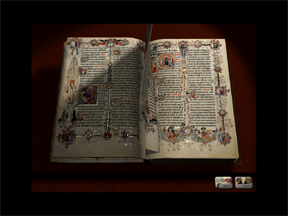 When users click on the top or bottom corner of the manuscript page and
drag the cursor to the opposite side of the book, they are presented
with an animation showing the page being turned over. If they release
the mouse button before the page has been pulled approximately 40% of
the way across the visible page spread, virtual
When users click on the top or bottom corner of the manuscript page and
drag the cursor to the opposite side of the book, they are presented
with an animation showing the page being turned over. If they release
the mouse button before the page has been pulled approximately 40% of
the way across the visible page spread, virtual gravity
takes over and
the page falls back into its original position.
§8. This is an amusing animation, and well suited to its intended purpose as an
interactive program that allows museums and libraries to give members
of the public access to precious books while keeping the originals
safely under glass
(
http://www.armadillosystems.com/ttp_commercial/home.htm).
Scholars interested in the texts as research objects, however, are
likely to find the system less attractive. The page-turning system uses
an immense amount of memory—the British Library estimates up to 1 GB of
RAM for high quality images (
http://www.armadillosystems.com/ttp_commercial/techspec.htm)—and
the requirement that users drag pages across the screen makes paging
through an edition a time- and attention-consuming activity: having
performed an action that indicates that they wish an event to occur
(clicking on the page in question), users are then required to perform
additional complex actions (holding the mouse button down while
dragging the page across the screen) in order to effect the desired
result. What was initially amusing rapidly becomes a major and
unnecessary irritation.
A Wheel of Memory: The Hereford Mappamundi (Reed Kline 2001)
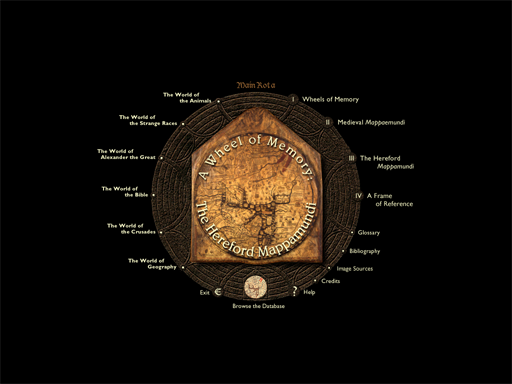 §9. Other innovations can be more harmful to the intellectual usefulness of a given
project. A Wheel of Memory: The Hereford Mappamundi uses the Mappamundi
as a conceit for the exploration of
§9. Other innovations can be more harmful to the intellectual usefulness of a given
project. A Wheel of Memory: The Hereford Mappamundi uses the Mappamundi
as a conceit for the exploration of the medieval collective memory... using
our own collective rota of knowledge, the CD-ROM
(Reed
Kline 2001,
I audio). The edition has extremely high production values. It contains
original music and professional narration. Images from the map6
and associated documents are displayed in a custom-designed viewing area that
is itself in part a rota. Editorial material is arranged as a series
of chapters and thematically organised explorations of different medieval
Worlds
: World of the Animals
, World of the Strange Races
,
World of Alexander the Great
,
etc. With the exception of four numbered chapters, the edition makes
heavy use of the possibilities for non-linear browsing inherent in the
digital medium to organise its more than 1000 text and image files.
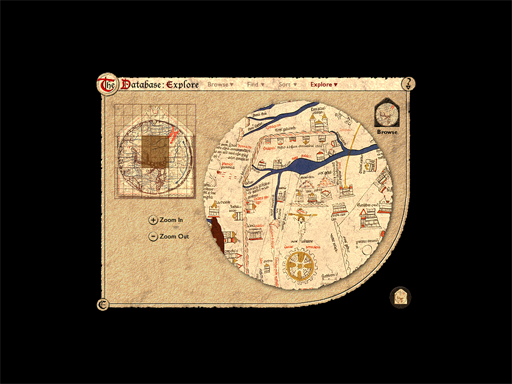 §10. In
this case, however, the project's innovative organisation and high
production values are ultimately self-defeating. Despite its heavy
reliance on a non-linear structural conceit, the edition itself is next
to impossible to use or navigate in ways not anticipated by the project
designers. Text and narration are keyed to specific elements of the map
and edition and vanish if the user strays from the relevant
§10. In
this case, however, the project's innovative organisation and high
production values are ultimately self-defeating. Despite its heavy
reliance on a non-linear structural conceit, the edition itself is next
to impossible to use or navigate in ways not anticipated by the project
designers. Text and narration are keyed to specific elements of the map
and edition and vanish if the user strays from the relevant hotspot
:
because of this close integration of text and image, it is impossible
to compare text written about one area of the map with a facsimile of
another. The facsimile of the map itself is also very difficult to
study.
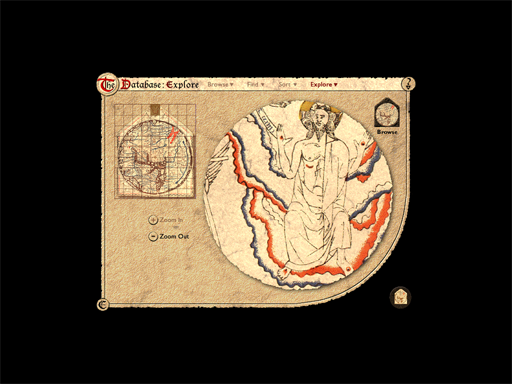 The customised viewing area is of a fixed size (I estimate
approximately 615×460 pixels) with more than half this surface given
over to background and navigation: when the user chooses to view the
The customised viewing area is of a fixed size (I estimate
approximately 615×460 pixels) with more than half this surface given
over to background and navigation: when the user chooses to view the whole map
on screen, the 4 foot wide original is reproduced with a diameter of
less than 350 pixels (approximately 1/10 actual size). Even then, it
remains impossible to display the map in its entirety: in keeping with
the project's rota conceit, the facsimile viewing area is
circular, even though the Hereford map itself is pentagonal: try as I
might, I was unable ever to get a clear view of the border and image in
the facsimile's top corner.
Using Technology to Transcend Print
§11. The
problem with the British Library and Hereford editions is not that they
use innovative technology to produce unconventional editions. Rather,
it is that they use this innovative technology primarily for effect
rather than as a means of contributing something essential to the
presentation of the underlying artifact. In both cases this results in
editions that are superficially attractive, but unsuited to repeated
use or serious study.7
The British Library facsimiles lose nothing if the user turns off the
"Turning the Page" technology (indeed, in the on-line version, an accessibility
option allows users precisely this possibility); leaving the technology
on comes at the cost of usability and memory. In the case of the
Hereford Mappamundi, the emphasis on the rota navigational
conceit and the project's high production values get in the way of the
map itself: the use of the round viewing area and fixed-width browser
actually prevents the user from exploring the entire map, while the
close integration of text, narration, and images ironically binds
readers more closely to the editor's view of her material than would be
possible in a print edition.
Bayeux Tapestry (Foys 2003)
§12. Appropriately used, innovative technology can create editions that transcend the possibilities of print, however. This can be seen in the third edition discussed in this paper, The Bayeux Tapestry: Digital Edition.8
§13. On the one hand, the Bayeux Tapestry edition uses technology in ways that, at first glance, seem very similar to the Hereford Mappamundi and British Library facsimiles. Like the Mappamundi project, the Bayeux edition has very high production values and is presented using a custom-designed user interface (indeed, the Hereford and Bayeux projects both use the same Macromedia presentation software). Like the British Library facsimiles, the Bayeux project uses technology to imitate the physical act of consulting the medieval artifact: users of the Bayeux Tapestry edition, like visitors to the Bayeux Tapestry itself, move along what appears to be a seamless presentation of the entire 68 metre long object.
§14. The difference between The Bayeux Tapestry: Digital edition
and the other two projects, however, is that in the Bayeux edition this
technology plays an essential role in the representation of the
underlying object. I am aware of no medieval manuscript that
incorporates the act of turning the page into its artistic design; the
Bayeux tapestry, however, was designed to be viewed as a single
continuous document
. By integrating hundreds of digital images
into what behaves like a single facsimile, the Bayeux project allows
users to consult the tapestry as its makers originally intended: moving
fluidly from scene to scene and pausing every-so-often to examine
individual panels or figures in greater detail.
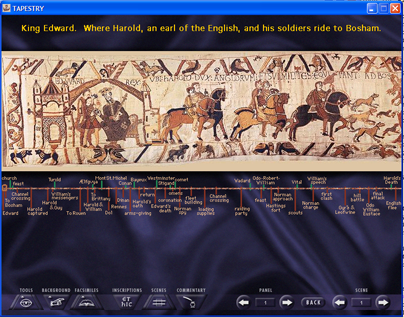 §15. The
organisation of the Bayeux edition is similarly well thought out. In
contrast to the Hereford Mappamundi project, the Bayeux project is
constructed around the object it reproduces. The opening screen shows a
section from the facsimile (few screens would be able to accommodate
the entire facsimile in reasonable detail) above a
§15. The
organisation of the Bayeux edition is similarly well thought out. In
contrast to the Hereford Mappamundi project, the Bayeux project is
constructed around the object it reproduces. The opening screen shows a
section from the facsimile (few screens would be able to accommodate
the entire facsimile in reasonable detail) above a plot-line
that provides an overview of the Tapestry's entire contents in a single
screen. Users can navigate the Tapestry scene-by-scene using arrow
buttons at the bottom left of the browser window, centimetre by
centimetre using a slider on the plot-line, or by jumping directly to
an arbitrary point on the tapestry by clicking on the plot-line at the
desired location. Tools,
background information, other facsimiles of the tapestry, scene
synopses, and notes are accessed through buttons at the bottom left
corner of the browser. The first three types of material are presented
in a separate window when chosen; the last two appear under the
edition's plot-line. Where the organisational conceit of the rota
prevented users from accessing the entire Hereford map, the structure
of the Bayeux edition encourages users to explore the entire length of
the Tapestry.
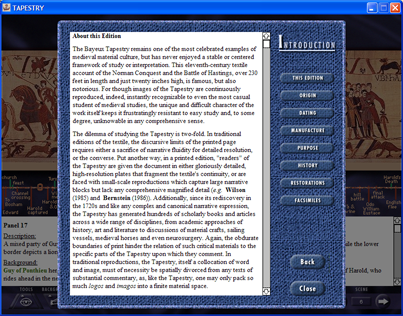
§16. The Bayeux project also does its best to
avoid imposing a particular structure on its editorial content. Where
the Hereford project proved extremely difficult to navigate in ways not
anticipated by its editor, The Bayeux Tapestry contains a slideshow
utility that allows users to reorder elements of the edition to suit
their own needs. While few readers perhaps will need to use this in
their own study, the utility will prove of the greatest benefit to
teachers and lecturers who wish to use the edition to illustrate their
own work.
Conclusion
§17. The interactivity, flexibility, and sheer novelty of digital media bring with them great challenges for the electronic editor. Where scholars working in print can rely on centuries of precedent in designing their editions, those working in digital media still operate for the most part in the absence of any clear consensus as to even the most basic expectations of the genre. This technological freedom can, on the one hand, be extremely liberating: electronic editors can now produce editions of a much wider range of texts, artifacts, and concepts than was ever possible in print. At the same time, however, this freedom can also lead to the temptation of using technology for its own sake.
§18. The three projects discussed in this column have been produced by careful and technologically sophisticated researchers. The differences among them lie for the most part in the way they match their technological innovation to the needs of the objects they reproduce. The British Library and Hereford Mappamundi projects both suffer from an emphasis on the use of advanced technology for largely decorative purposes; both would be easier to use without much of their most superficially attractive technological features. The Bayeux Tapestry project, on the other hand, succeeds as an electronic text because it uses advanced technology that is well suited to its underlying object and allows it to be presented in a fashion difficult, if not impossible, in any other medium. Users of the British Library and Hereford facsimiles may find themselves wishing for a simpler presentation; few users of the Bayeux tapestry would wish that this edition had been published in book form.
Notes
1. This is a commonplace. For an influential discussion,
see McGann 1995. Strictly speaking, print
and digital/electronic
in this discussion refer to accidentals of display rather than
essential features of composition and storage. Texts composed and
stored digitally can be displayed in print format, in which case they
are subject to the same limitations as texts composed and stored
entirely on paper. The importance of this distinction between
composition and display is commonly
missed in early theoretical discussions, which tend to concentrate
exclusively on
possibilities for on-screen display. In fact, as recent commercial and scholarly
applications of xml are demonstrating, the real advantage of electronic
composition and storage is reusability. Properly designed electronic
texts can be published simultaneously in a number of different formats,
allowing users to take advantage of the peculiar strengths and
weaknesses of each. In my view, the most profound difference between
electronic and print texts lies in the separation of content and
presentation which makes this reuse of electronic texts possible.
[Back]
2.
It is easy to overemphasise the limitations of print and the
flexibility of digital display. While books are for the most part physically
static and two dimensional (the main exception are books published as
loose pages intended for storage in binders or picture books with three
dimensional figures), they are intellectually flexible: readers
are free to reorganise them virtually
by paging back and forth or using
a table of contents or index to find and extract
relevant information. In certain cases, e.g. dictionaries and
encyclopedias, this intellectual flexibility is an essential feature of
the genre. Not surprisingly, these genres were also among the first and
most successful titles to be published in electronic format. Screens,
for all their flexibility and interactivity, remain two-dimensional
display devices subject to many of the same limitations of the printed
page. [Back]
3. Robinson's important article came to my attention after this column was in proof. [Back]
4. The observation that these examples are missing one or more traditional
elements of a print edition is not intended as a criticism. Not all
editions need all traditional parts, and, in several cases, the
editorial approach used explicitly precludes the inclusion of the missing
element. What the observation does demonstrate, however, is that no strong consensus
exists as to what must appear in an electronic critical edition. The
only thing common to all is the presence of facsimiles. [Back]
5. One possible objection to the above list of examples is that I am mixing editions produced using very different technologies over the greater part of a decade (a long time in humanities computing). This technical fluidity is one of the reasons for the lack of consensus among electronic editors, however. Since in most cases, moreover, the technology has aged before the editorial content (eight years is a relatively short time in medieval textual studies), the comparison is also valid from a user's perspective: as a medievalist, I am as likely to want to consult the first disc in the Canterbury Tales Project as I am the most recent. [Back]
6. As is noted in the introduction to the edition, the facsimile reproduces a nineteenth-century copy of the Hereford map rather than the medieval Mappamundi itself. The images in the Bayeux disc discussed below are similarly based on facsimiles—albeit in this case photographs of the original tapestry. [Back]
7. This is less of a problem in the case of the British Library series, which presents itself primarily as an aid for the exhibition of manuscripts to the general public rather than a serious tool for professional scholars. The intended audience of the Mappamundi project is less certain: it is sold by a university press and seems to address itself to both scholars and students; much of its content, however, seems aimed at the high school level. The design flaws in both texts seem likely to discourage repeated use by scholars and members of the general public alike. [Back]
8. In the interests of full disclosure, readers should be aware that I am currently associated with Foys in several on-going projects. These projects began after the publication of Foys 2003, with which I am not associated in any way. [Back]
Works Cited
Adams, Robert, Hoyt N. Duggan, Eric Eliason, Ralph Hanna III, John Price-Wilkin, and Thorlac Turville-Petre, eds. 2000. Corpus Christi College Oxford MS 201 (F) [Electronic text]. The Piers Plowman Archive, 1. Ann Arbor: University of Michigan Press. [Back]
Bordalejo, Barbara, ed. 2003. Caxton's Canterbury Tales: The British Library Copies on CD-ROM [Electronic text]. Cambridge: Boydell. [Back]
Foys, Martin K., ed. 2003. The Bayeux Tapestry: Digital Edition [Electronic text]. Leicester: SDE. [Back]
Greetham, D. C. 1994. Textual scholarship: an introduction. Garland Reference Library of the Humanities, 1417. New York: Garland. [Back]
Kiernan, Kevin S., ed. 1999. The electronic Beowulf [Electronic text]. London: British Library. [Back]
McGann, Jerome. 1995. The rationale of hypertext.
Web page [accessed February 9, 2005]. Available at
http://www.iath.virginia.edu/public/jjm2f/rationale.htm. [Back]
McGillivray, Murray, ed. 1997. Geoffrey Chaucer's Book of the Duchess: A hypertext edition [Electronic text]. Calgary: University of Calgary Press. [Back]
Reed Kline, Naomi, ed. 2001. A Wheel of Memory: The Hereford Mappamundi [Electronic text]. Ann Arbor: University of Michigan Press. [Back]
Robinson, Peter. 2005. Current issues in
making digital editions of medieval texts—or,
do electronic scholarly editions have a future?
Digital Medievalist 1.1. Online journal [accessed
June 29, 2005]. Available at http://www.digitalmedievalist.org/article.cfm?RecID=6 [Back]
Slade, Benjamin, ed. 2002-2003. Beowulf on Steorarume [Beowulf in Cyberspace]. Web site [accessed February 9, 2005]. Available at http://www.heorot.dk/. [Back]
De Smedt, Marcel and Edward Vanhoutte, eds. 2000. De teleurgang van den Waterhoek [Electronic text]. Amsterdam: Amsterdam University Press. [Back]
Stolz, Michael, ed. 2003. Sankt Galler Nibelungenhandschrift (Cod. Sang. 857): Parzival, Nibelungenlied, Klage, Karl der Groe, Willehalm [Electronic text]. Codices Electronici Sangallenses 1. St. Gallen: Stiftsbibliothek St. Gallen-Projekt Basel. [Back]
Solopova, Elizabeth, ed. 2000. The General Prologue on CD-ROM [Electronic text]. The Canterbury Tales Project, [vol. 2]. Cambridge: Cambridge University Press. [Back]
West, Martin L. 1973. Textual criticism and editorial technique applicable to Greek and Latin texts. Stuttgart: B. G. Teubner. [Back]
Willis, James. 1972. Latin textual criticism. Illinois Studies in Language and Literature, 61. Urbana, IL: University of Illinois Press. [Back]
